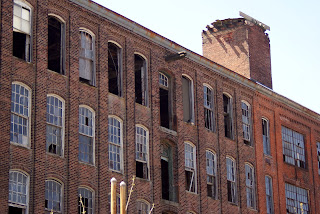Thomas Buck Hosiery Mill Fire, 9 April 2012
This morning, in my daily perusal of philly.com, I came upon the horrible news that two firefighters had been killed, and three more injured, fighting a 5-alarm blaze in the Kensington section of Philadelphia. When I came upon the second paragraph of the story, it hit me square in the nose: the factory building destroyed by this fire was precisely the one my brother and I had gone to see on Saturday in our ongoing attempt to document the city's architectural heritage photographically.
Indeed, it had been my intention for some time to travel to Kensington and North Philadelphia on this mission. I decided to visit the 19th-century Buck Mill because of an article in the Hidden City Philadelphia blog on 30 March, which portrayed the simultaneous grandeur and decrepitude of the factory, which had been vacant since the 1970s.
Now it is gone, like many other former factories in the neighborhood whose only remains are the trash-strewn empty lots that comprise their footprint, awaiting redevelopment. And this provokes an overwhelming melancholy in the core of this Main Line suburbanite. As they say, they just don't—indeed, our "advanced" culture can't—build them like this any more. Many old mills in Kensington and Fishtown have been salvaged and restored, but many more—all of them brawny monuments to the time when Philadelphia was truly the "Workshop of the World"—remain on the endangered list, and there is only so much money to go around.
As always, events like this lead me to reflect theologically on transience. "All flesh," the prophet Isaiah proclaimed, "is grass, and all its beauty is like the flower of the field.... The grass withers, the flower fades, but the word of our God will stand forever" (Isa 40:6, 8). This, of course, was written of human beings, the only hope for whom is rooted in the event celebrated on Easter morning. But all of us will die, and everything we do and make is subject to the decay that characterizes the creation of which we are a part. Nothing of what we have made will ultimately survive, no matter how hard we work to assure its longevity. That, of course, includes masterpieces of architecture like Chartres Cathedral, the U.S. Capitol—yes, even Philadelphia's City Hall—as well as such seemingly pedestrian structures as the Buck Mill.
What will remain is that which is associated with the New Creation inaugurated in the resurrection of the Son of God on Easter Day, 5 April 33 CE. This is the macrocosmic New Creation of which we who know Christ have been made microcosms (2 Cor 5:17). How much more, then, should we heed the admonition of our Lord, who said:
Do not store up for yourselves treasures on earth, where moths and vermin destroy, and where thieves break in and steal. But store up for yourselves treasures in heaven, where moths and vermin do not destroy, and where thieves do not break in and steal. For where your treasure is, there your heart will be also. (Matthew 6:19-21, NIV)I leave you with a number of the photographs I took of the Buck Mill 36 hours before it met its fiery fate.















Nice pics
ReplyDeleteMr. McGahey, I'm revising a textbook on fire prevention. I'd like to discuss buying the rights to reprint one of your photographs. Dave Diamantes you can reach me at ddiam at visual link dot com
ReplyDeleteThank you.